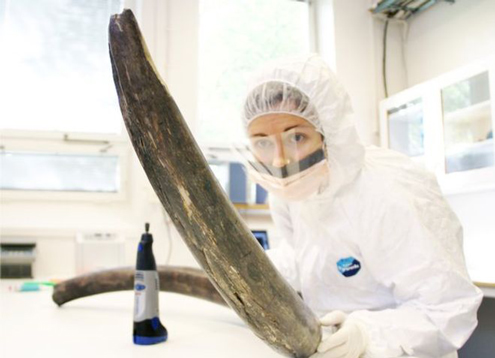Chilesaurus diegosuarezi – A theropod that Took a Very Different Path
It may have been little more than three metres long and if it had been included in the forthcoming dinosaur film “Jurassic World”, this little dinosaur would not have lingered long in the film goers memory but the publication of a scientific paper on the newly described Chilesaurus (C. diegosuarezi) represents a very big deal for the scientific community. Here is a member of the theropod dinosaur family, distantly related to the likes of Allosaurus, Velociraptor, Spinosaurus and T. rex that evolved into a plant-eater and what a bizarre looking dinosaur Chilesaurus is. It does look like a dinosaur designed by a committee.
Chilesaurus
An Illustration of the Newly Described Patagonian Dinosaur C. diegosuarezi
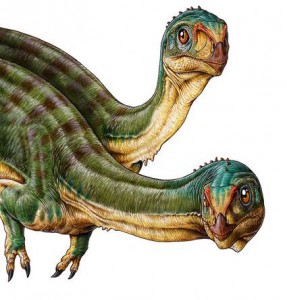
A curious little dinosaur from southern Chile.
Picture credit: Gabriel Lio
A Bizarre Dinosaur
Theropod dinosaurs were the dominant land predators throughout most of the Mesozoic era. It is thought that the very first dinosaurs, those that evolved perhaps as early as 240 million years ago, had very similar body plans. They were small, fast running, agile predators that had long tails, slender legs and for the most part were entirely carnivorous. These were the lizard-hipped dinosaurs, the Saurischia, one of two great divisions into which all the dinosaurs are divided, the other division being the bird-hipped dinosaurs, the Ornithischia.
Classifying Dinosaurs
It was a British scientist, Harry Govier Seeley, who in 1888, classed the then known dinosaurs into one of two clades based on the structure of the bones that make up their hip girdles. Lizard-hipped forms which include the theropods have their pubis bone projecting forward (usually see below), in contrast to the bird-hipped forms that have the pubis bone pushed backwards.
Chilesaurus is a member of the lizard-hipped clade. It is a theropod and palaeontologists know that the Theropoda are perhaps the most diverse Suborder of all the Dinosauria, but no one quite anticipated such a bizarre looking dinosaur from one of the southern most parts of the South American continent.
Classifying Dinosaurs by their Hip Structures
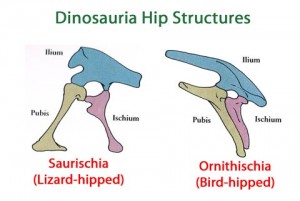
Classifying dinosaurs by the shape of their hip bones.
Picture credit: Everything Dinosaur
From the Aysén Region of Southern Chile
The beautiful, mountainous and sparsely populated Aysén region of southern Chile was being explored by a Chilean couple, both of whom are geologists (Manuel Suarez and Rita de la Cruz), back in 2004 when the fossils of this strange dinosaur were discovered. This remote part of Chile is renowned for its extensive mineral deposits, but whilst exploring a rocky exposure near General Carrera Lake, the son, Diego, who was seven at the time, picked up a couple of odd looking objects.
The parents recognised these as a partial rib and a vertebra and the family set about searching the immediate area to find more fossilised bones. Sister Macarena joined in and in a short while the family had collected quite a number of bones representing several individual animals. Over the last decade or so, a team of South American scientists have been piecing together the evidence and this has led to the naming of this new and very unusual genus.
Abundant Fossil Material
One of the lead authors of the scientific paper published in the journal “Nature”, Dr Fernando Novas (Museo Argentino de Ciencias Naturales (Buenos Aires, Argentina), explained:
“I don’t know how the evolution of dinosaurs produced this kind of animal, what kind of ecological pressures must have been at work. What’s surprising is that in this locality the most bizarre dinosaur is not the exception, but the rule. It is the most abundant animal we find.”
A Skeletal Drawing and Illustration of Chilesaurus diegosuarezi
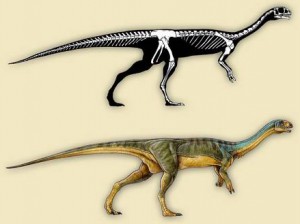
Light, agile plant-eating dinosaur.
Picture vredit: Gabriel Lio
Chilesaurus
Chilesaurus ran around on long legs, each foot had four toes. The forelimbs were less than a third the size of its hind legs, so it retained the bipedal stance of its meat-eating ancestors, but the neck was long and slender and the skull small. The teeth had evolved, squared-off tops, adaptations to a diet of plants. The jaw supported a beak, very reminiscent of those beaks seen in bird-hipped dinosaurs like Stegosaurus and Triceratops. The hands were reduced and only two fingers had claws, the third finger was little more than a stump and effectively vestigial.
A spokesperson from Everything Dinosaur commented:
“Chilesaurus, shows anatomical characteristics quite unlike any other theropod dinosaur. For example, the pubis bone is projecting backwards, which is similar in orientation to the layout of the pelvic girdles of ornithischian dinosaurs, but other features identify this as a member of the lizard-hipped Theropoda.”
Four-toed Hind Feet
All four toes of the hind feet supported the weight of the animal, whilst in the Theropoda, the vast majority of these animals have a tri-dactyl (three-toed stance). It seems that this plant-eater, not having the need to pursue prey was slowly evolving a foot morphology similar to the early plant-eating Prosauropods.
Excavating Fossil Bones in the Beautiful Aysén Region of Southern Chile
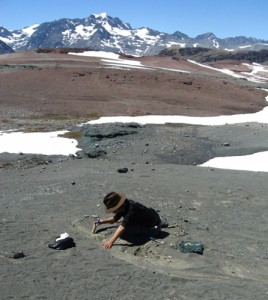
A beautiful but very remote fossil dig site.
Picture credit: Dr Fernando Novas
The Upper Jurassic Toqui Formation
The strata in this region of southern Chile is part of the Upper Jurassic Toqui Formation and dates to around 145 million years ago. Apart from the numerous fossils of Chilesaurus, which represent a number of individual animals at various stages of growth, the site has yielded a number of archosaur remains as well as several crocodyliforms and highly fragmentary remains of a few sauropods tentatively assigned to diplodocid and titanosaurians.
How to classify this little dinosaur with its strange mix of features? The scientists have described this dinosaur as a basal tetanuran, a distant relative of the likes of the tyrannosaurs, dromaeosaurs and the Therizinosauridae, a family of theropods associated with Cretaceous deposits that also adapted to a herbivorous diet. The genus name reflects the location of the fossil discovery. Chilesaurus is the first complete dinosaur from the Jurassic geological period found in Chile and the fossils represent one of the most complete and anatomically documented theropod dinosaurs known from the Southern Hemisphere.
Dr Novas added:
“Although plant-eating theropods have been recorded in North America and Asia [Therizinosauridae], this is the first time a theropod with this characteristic has been found in a southern landmass.”
A Fragment of Jaw from a Juvenile Showing the Bizarre Teeth
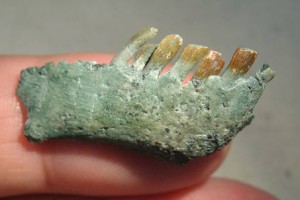
Teeth adapted for cropping plants.
Picture Credit: Dr Fernando Novas
This bizarre Late Jurassic theropod dinosaur really looks like it has been designed by a committee!
Papo added a Chilesaurus to their model range to view Papo prehitoric animal figures: Papo Prehistoric Animal Models and Figures.
Note
In the light of a redefinition of the Dinosauria and the uniting of the Theropoda and ornithischian dinosaurs into a new clade the Ornithoscelida, Chilesaurus has been newly described as a basal member of the Ornithischia (update as of August 2017).


